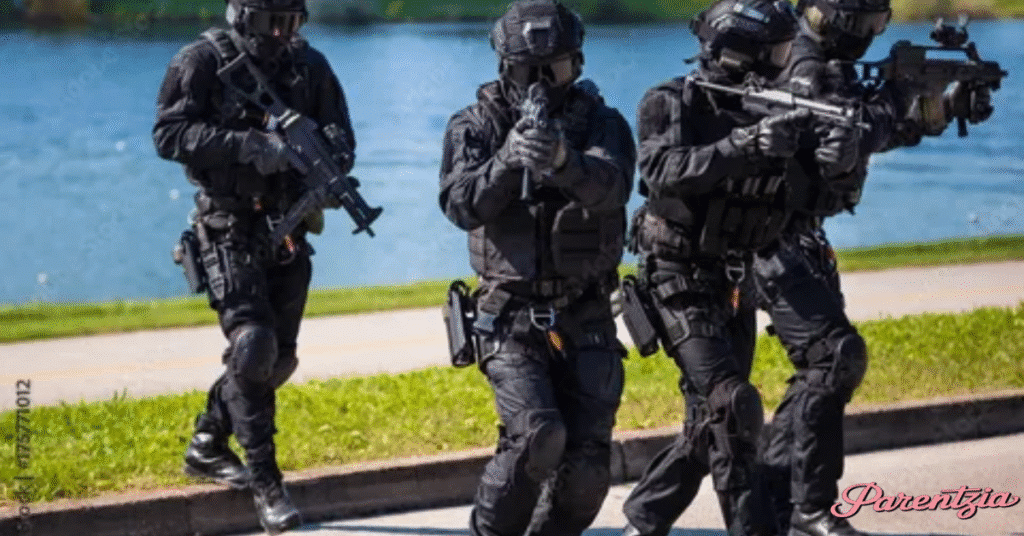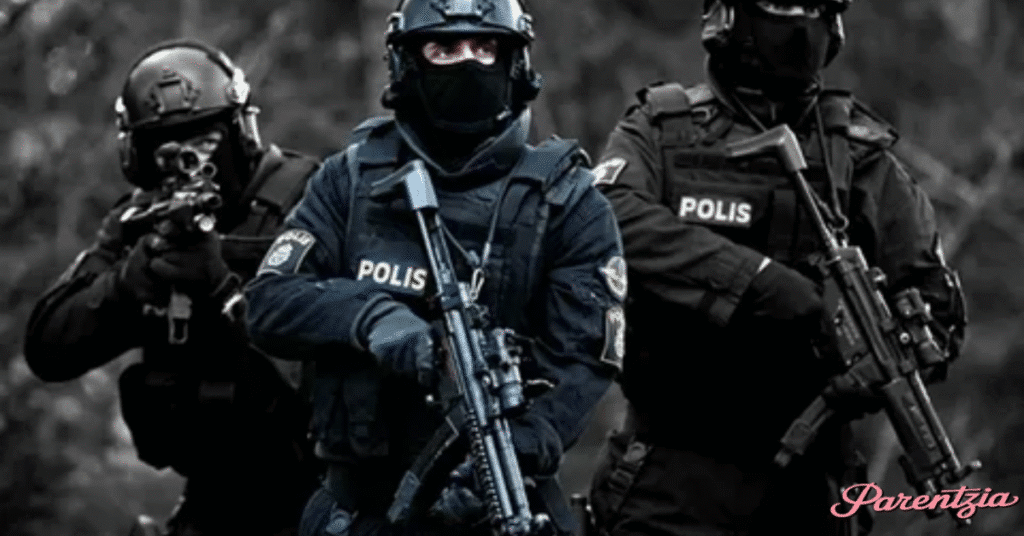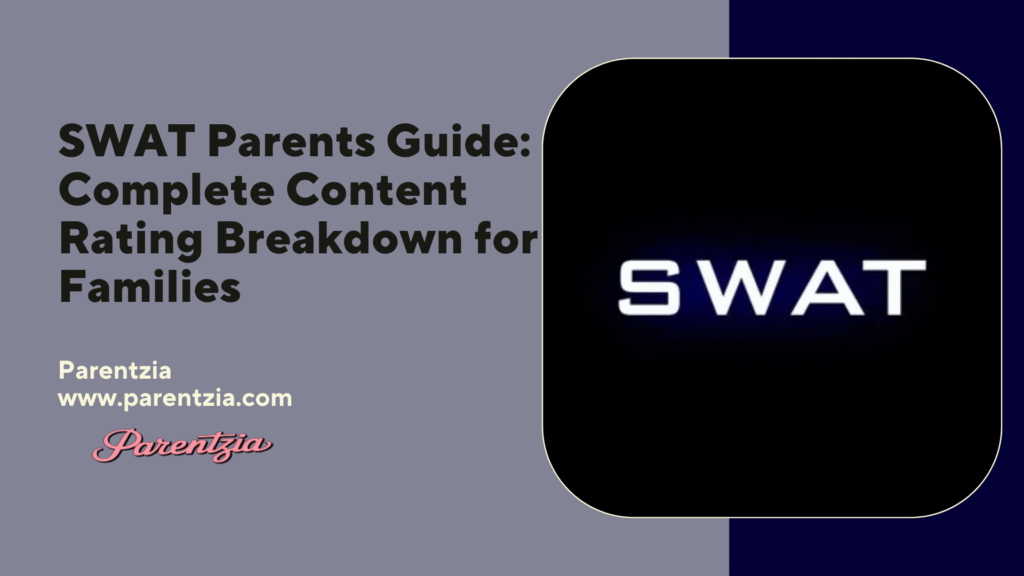Parents often wonder whether the action-packed series S.W.A.T. is suitable for teens or younger viewers. The show mixes adrenaline-fueled raids, tactical operations, and character-driven storylines with moments of violence, strong language, and adult themes. While S.W.A.T. offers plenty of heroic moments and positive role models, it also dives into gritty law enforcement situations that may not be appropriate for all ages.
This SWAT Parents Guide provides a clear and detailed breakdown of everything parents should know before letting their kids or teens watch. We’ll explore sex & nudity, violence & gore, profanity, alcohol, drugs & smoking, and frightening & intense scenes. In addition, we’ll highlight positive messages, role models, and give a realistic age recommendation to help you make an informed choice.

you might also like “The Jackal Parents Guide: A Complete Content Rating Breakdown”
Sex & Nudity in SWAT
One of the first concerns parents raise is whether S.W.A.T. contains sexual references, partial nudity, or explicit material. Thankfully, the show leans heavily on action and police drama rather than steamy romance. That said, certain elements still exist that parents should know.
What Parents Can Expect
- Sexual references: Characters sometimes use flirtatious dialogue, teasing remarks, or mild innuendo. These are generally brief and not overly graphic.
- Partial nudity: Rare scenes may show a character in underwear or shirtless, often during personal moments at home. These are usually short and not sexualized.
- Clothed intimacy: Occasional kissing between characters or romantic subplots appear, but there’s no extended sexual activity shown on-screen.
- Flirting: Some interactions, particularly involving off-duty relationships, include casual flirting but remain mild compared to shows aimed at adult audiences.
Parental Perspective
The sexual content level is relatively low compared to other crime dramas. There’s no nudity, no explicit bedroom scenes, and no graphic sexual activity. For parents worried about exposure, S.W.A.T. fits into a moderate category: teens will notice the intimacy, but it doesn’t dominate the narrative.
Quick Note: If compared with police shows like NCIS: Los Angeles or Chicago P.D., S.W.A.T. is fairly restrained in this department.
Violence & Gore in SWAT
The heart of S.W.A.T. lies in its tactical missions, which means violence & gore play a central role. From high-speed chases to shootings and intense action violence, this is the element parents must weigh carefully.
Common Violent Elements
- Gunfire: Almost every episode features gun violence with loud bursts of automatic weapons and pistols.
- Explosions: Bomb threats and tactical breaches often involve loud, fiery explosions that may startle younger viewers.
- Physical assaults: Fistfights, tackles, and takedowns occur regularly during arrests or raids.
- Injuries: Most injuries are portrayed without graphic gore. Wounds may be shown briefly, but heavy blood and gore are avoided.
- Public danger: Episodes frequently depict crowded areas under threat — banks, schools, or public gatherings. This can heighten tension.
Violence Severity Rating
- Violence severity: moderate to strong depending on the storyline.
- Action sequences: Rapid-paced and realistic, emphasizing tactical coordination rather than gratuitous blood.
- Bloodless but intense: Most shootings don’t linger on gore, but the constant presence of weapons makes the atmosphere tense.
Table: Violence Breakdown by Category
| Type of Violence | Frequency | Graphic Level | Parental Concern |
|---|---|---|---|
| Shootings | High | Moderate | Startling, but not bloody |
| Explosions | Moderate | Low | Loud, chaotic scenes |
| Hand-to-hand combat | Moderate | Mild | Brief but intense |
| Injuries shown | Low | Mild | Minimal blood shown |
Parental Perspective
If your child is sensitive to gun violence or threat scenes, S.W.A.T. may feel overwhelming. The action violence is relentless, though stylized for network television. It’s best suited for teens who can handle action films like Mission Impossible or Fast & Furious.

Profanity in SWAT
Language is another area where parents often pause. S.W.A.T. characters, being law enforcement professionals under pressure, sometimes use profanity and strong language.
What’s Included
- Cuss words: Expect common swearing like “hell,” “damn,” or “s–t” used in stressful moments.
- Frequent expletives: In some intense episodes, characters may curse multiple times during shootouts or arguments.
- Obscenities and cursing: The dialogue avoids highly offensive slurs but doesn’t shy away from cuss words that push toward a TV-14 or higher rating.
Language Level Rating
- Language level: moderate.
- No explicit racial or hate slurs in standard episodes.
- Expletives appear, but often in the heat of action rather than casual use.
Parental Note: Compared to streaming police dramas, S.W.A.T. contains less severe swearing. However, younger kids may still repeat phrases they hear, so caution is advised.
Alcohol, Drugs & Smoking in SWAT
Like many police dramas, S.W.A.T. occasionally touches on alcohol, drugs & smoking, but not to the point of glorification.
Alcohol Use
- Bar scenes: Team members sometimes socialize in bars or at gatherings, holding drinks casually.
- Drinking: Light social drinking is shown, but intoxication is minimal.
Drug References
- Substance use: Storylines often involve criminals trafficking drugs, though the intoxication level: mild on-screen. Characters rarely use drugs themselves.
- Illegal narcotics: The show may show seized drugs or depict drug-related arrests.
Smoking
- Smoking depiction: Smoking is rare, though occasional background characters may light a cigarette.
Portrayal
Overall, alcohol portrayal remains casual, with drugs and smoking linked to crime rather than glamorization. This helps discourage impressionable viewers from seeing it as “cool.”
Frightening & Intense Scenes in SWAT
Beyond violence, the frightening & intense scenes can be emotionally overwhelming. Parents should consider how suspense and psychological tension affect younger viewers.

What Makes It Intense
- Hostage situations: Some episodes revolve around terrorists or criminals holding people at gunpoint.
- Peril: Innocent civilians — including children — are sometimes placed in danger.
- Suspense: Episodes build tension with threat scenes, ticking clocks, and unexpected betrayals.
- Emotional impact: The intensity level: moderate to high depending on the episode.
Examples
- A school under lockdown after a gunman enters.
- A bus hijacking with civilians trapped inside.
- Explosives strapped to a hostage with limited time to defuse.
These scenarios are designed for thrills but may trigger anxiety in sensitive viewers.
Positive Messages & Role Models in SWAT
While the show contains violence and strong themes, it also emphasizes positive messages worth noting.
Teamwork and Loyalty
- The S.W.A.T. unit works as a tight-knit team, demonstrating collaboration under high stress.
- Members support each other emotionally, often putting the group’s needs before personal desires.
Duty and Sacrifice
- The show highlights the weight of responsibility officers carry to protect civilians.
- Characters often face tough moral dilemmas, teaching viewers about sacrifice and ethics.
Role Models
- Hondo, the lead character, embodies fairness, integrity, and leadership.
- Female officers are portrayed as competent and resilient, offering strong role models for young viewers.
Age Rating Recommendation for SWAT
The official rating for S.W.A.T. is TV-14, which means it may not be suitable for children under 14 due to violence & gore, profanity, and frightening & intense scenes.
Suggested Viewing Ages
- Under 13: Not recommended due to heavy action violence and strong language.
- 14–16: Suitable with parental guidance; teens in this range can handle the themes with discussion.
- 17+: Most content aligns with what older teens and adults expect in action series.
Conclusion
This SWAT Parents Guide makes one thing clear: while S.W.A.T. offers inspiring portrayals of teamwork, loyalty, and duty, it also includes intense action violence, profanity, and suspense that may be too much for younger audiences.
For families, the best approach is to watch with your teens, talk through the heavy moments, and emphasize the positive role models the show highlights. With guidance, S.W.A.T. can be more than just a tactical thrill ride — it can also spark meaningful conversations about courage, sacrifice, and justice.

Tina Grey is an experienced blogger with a passion for uncovering the best in film. With years of writing and a keen eye for detail, Tina brings insightful reviews and engaging content to Parentzia. Her deep love for movies, combined with her expertise, helps readers discover must-watch films across genres. When she’s not reviewing, Tina enjoys exploring new cinematic trends and sharing her love of film with her audience.







